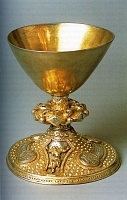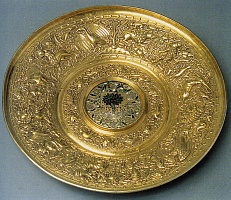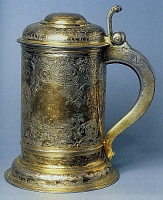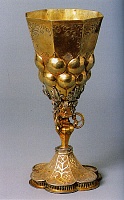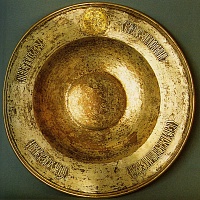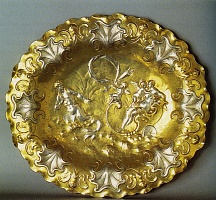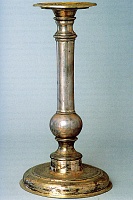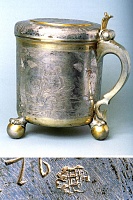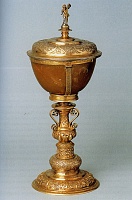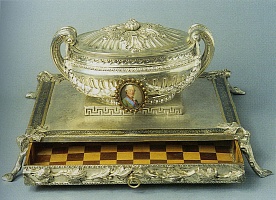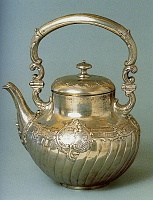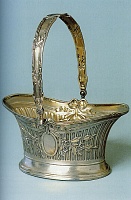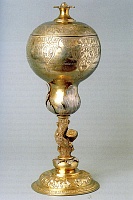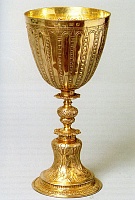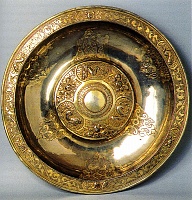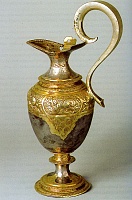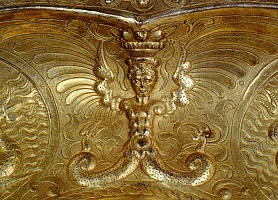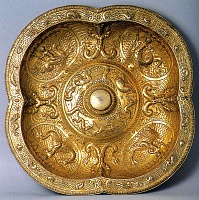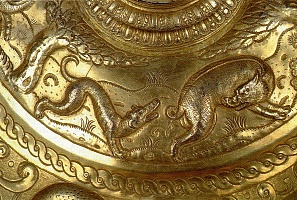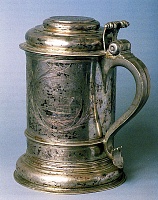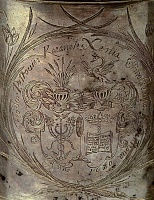European silver 14th - 19th centuries
The Museum collection of European silver is not large, yet it gives an idea of the level and quality of several European centers, presenting items that are by no way ordinary. Many items are rare. The group of the unique specimens includes the German chalice of the first three decades of the 14th century which is one of the earliest items in the museums of our country; the Lisbon dish of the late 15th century – the heyday of Portugal culture; English silver of Elizabeth’s time.
The chronological boundaries are rather wide – from the 14th till early 20th century, the stylistic range is from Gothic to Modern art. The works of German and English craftsmen are most interesting for their quantity and quality. The 18th – 19th century of Portuguese, Dutch, Swedish, Polish, Belgian, French silversmiths are represented by single items
German silver of the 14th – 19th Centuries
The collection of German jewelry art is most complete. It is only natural, considering the distinguished place occupied by German metal in history of West-European applied art of the 15th – 17th century. Apart from the works of such major centers as Nuremberg, Augsburg, Hamburg, the collection includes single items (or just fragments)made by Lubeck, Dresden, Leipzig, Essen, Munster, Rostock and Breslau craftsman. The earliest work of German silversmiths in the Museum collection is the chalice of the first three decades of the 14th century, donated to the Trinity Monastery by Tsar Ivan the Terrible. This Gothic vessel is a rare and, most probably, unique specimen in our museum collections.
Nuremberg. The collection of Nuremberg silver is represented by the works of the second half of the 16th – first three decades of the 17th century. Stylistically they are Renaissance and Baroque monuments . In Nuremberg it was the time of jewelry art flowering, the time of mass production of precious articles and their wide-spread occurrence in Germany and far outside the country. Of all kinds of objects the collection presents goblets - the most characteristic works of the Nuremberg silversmiths. Since the late 16th century, a silver gilded goblet, of German work as a rule, was the most significant and valuable present for representatives of higher society in Russia. The Museum collection includes goblets made by Nicolaus Schmidt, Caspar and Hans Beutmuller.
Аugsburg. Augsburg is another center of German silver work. It is represented by a more diverse group of the 16th – early 18th century articles. Augsburg was formed as a major center of silverwork in the Renaissance epoch in the second half of the 16th century. The Augsburg Renaissance artists created whole albums and series of sheets with ornaments for gold- and silversmiths. The goblet with the Augsburg master’s mark “The crossed hatchets” is an example of their use. The gilded pounced goblet with an egg-shaped bowl can be referred to the late Renaissance Augsburg silver.
The second half of the 17th and the first half of the 18th century became the best periods in Augsburg silverwork. The silversmiths successfully mastered new decorative motifs and ornaments in silver tableware. Few items from the Museum collection demonstrate luxury and variety of baroque ornaments. The baroque dish-basin made by the Augsburg master Hans Jacob I Baur from the Museum collection is brilliantly chased. With impressive size, glittering precious metal and interesting theme “The Triumph of Amphitrite” it looks like a magnificent panel. Both in Europe and in Russia such “basins” were fixed on the walls or exhibited on special stands in the palace halls.
Hamburg and other German towns. The third major center of German artistic silver is represented by several items. There are three Hamburg mugs. The mug is a specific kind of tableware. It appeared in German Renaissance culture. The high cylindrical vessel on a low bottom or without any base, with a necessary lid and handle was widespread in Germany. One of the mugs in the Museum collection is thickly covered with engraved patterns and narrative compositions.
In 16th-17th centuries, German masters skillfully worked not only with silver, but also with the diversified materials, often exotic: a stone, rock crystal, a coco, amber, nacre. Such products had known in Europe since antique times. The example to that is a cup with a bowl from jasper. Vessels from jasper both in Europe and in Russia were appreciated not only beauty of a stone, transparent in a thin layer and various on colour. These subjects supplement an overall picture of gold and silver business of Germany, to no miscellaneous expressing to the tendency of regional art and reflecting various steps of development of styles of the Renaissance and baroque.
German Classical silver is represented by the inkstand made by a Dresden silversmith in the third quarter of the 18th century. The inkstand is shaped like an antique urn on a square bottom. The models for such works were antique archeological finds from Herculaneum and Padua in Italy. The Museum sample of the so-called “stylistic shape”, i. e. made in a certain style, is the rococo tea-pot. Its body with an elongated spout and wavy surface, intricate floral pattern with a shell (“rocaille”) motif reproduce the rococo shapes.
English silver of the 16th-17th centuries
The Museum includes a small, but interesting collection of the 16th – 17th century English silver that is considered the best in the world. English silver articles came to Russia as ambassadorial and diplomatic presents. The works of English silversmiths of the Tudors and Stuarts period were preserved not only in the royal treasury. As gifts and contributions, English goblets, mugs, plates, jugs were also included in the monastery sacristies.
In England Renaissance spread in applied art later then in Continental Europe. English silversmiths were noticeably influenced by the craftsmen of Germany and Netherlands. The works of British Renaissance craftsmen are distinguished by the logical and symmetrical structure, clear shape, emphasized functional parts. English silver of that time looks rather simple and bourgeois. The plain shapes and even contours correspond to the British solidity and reserved decorativeness.
The goblet 0f 1584 – 1585 made by Semeone Brooke is a characteristic work of English Renaissance silver. The “pumpkin” shape is borrowed from German craftsmen. The goblet is decorated with a thing engraved pattern. The other goblet with a deep, egg-shaped bowl, solid foot and characteristic bell-shaped bottom is typically insular. The Museum collection also comprises the wash-hand set. The jug is a high elegant vessel shaped like a vase. The upper part of the jug is decorated with a stripe of a chased ornament of oval medallions depicting sea monsters. The decoration of the matching dish-basin is austere and modest.
There is another similar dish. Its surface is thickly covered with a chased and engraved pattern. The bottom id decorated with chasing in high relief: there are hunting scenes around the raised central part, tritons against the sea waves in medallions along the external ring and winged “snake-legged” sea-cows. The wide edge is decorated with a thick wavy ornament with chased dolphins, fish, snails and shells. No wonder that such a sea power like England had a lot of decorative elements in applied art.
The mug of 1670 with master’s monogram “AL” and large engraved ornament is referred to baroque style. Its floral decoration reflects a leading trend in English and European silver in the mid-17th century. The mug’s body is adorned with three large roundels . The central roundel depicts a double emblem. Architectural landscapes are engraved on the sides. The lower part is decorated with a floral pattern.
All these items are magnificent works of English silversmiths. They give a vivid idea of peculiarities and quality of the world-famous artistic craft. The 16th – 17th British silver is characterized by natural harmony, absence of excessive decoration and generally high artistic level.









